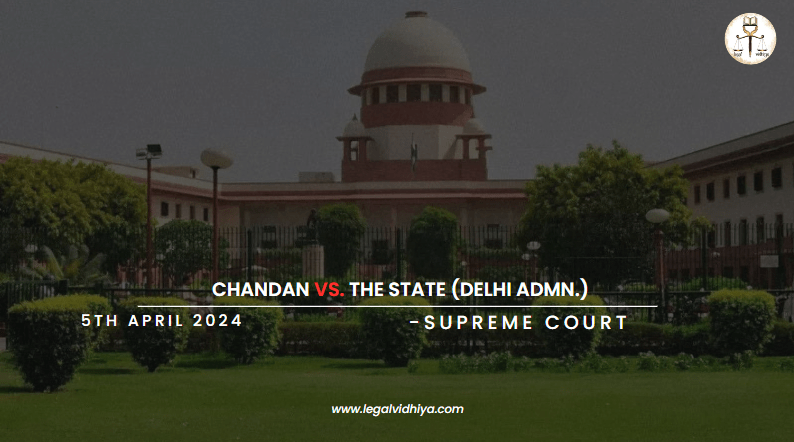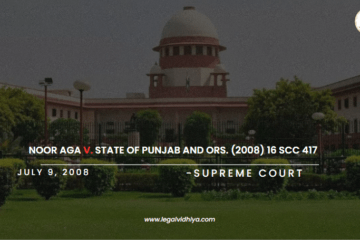
| CITATION | 2024 INSC 271 |
| DATE OF JUDGMENT | 5th April 2024 |
| COURT | Supreme Court of India |
| APPELLANT | Chandan |
| RESPONDENT | The state (Delhi Admn.) |
| BENCH | Justice Sudhanshu Dhulia and Justice Prasanna B. Varale |
INTRODUCTION
The case of Chandan vs. The State (Delhi Admin.) delves into a harrowing tale of a fatal stabbing incident that unfolded on 28th May 1993, leading to the tragic death of the victim, Rakesh. The accused, Chandan, stands at the center of this legal saga, accused of perpetrating the heinous crime by stabbing the deceased multiple times with a knife before fleeing the scene. The prosecution’s case heavily relies on the testimony of a crucial eyewitness, PW-2, who vividly recounts the sequence of events leading to the fatal confrontation between the accused and the deceased.At the heart of the legal proceedings lies the prosecution’s endeavour to establish the guilt of the accused beyond a reasonable doubt, despite the absence of a discernible motive for the crime. The recovery of the blood-stained murder weapon from the accused, coupled with forensic evidence linking the weapon to the victim, serves as a cornerstone of the prosecution’s case.
The Trial Court and the Appellate Court meticulously examined the evidence presented, ultimately affirming the conviction of the appellant under Section 302 of the Indian Penal Code. The appellate review process underscored the significance of direct evidence and the credibility of eyewitness testimony in substantiating the prosecution’s claims and ensuring justice is served in cases of grave criminal offences.
This case encapsulates the intricate legal intricacies involved in criminal trials, emphasizing the critical role of evidence, witness testimonies, and judicial scrutiny in adjudicating matters of profound societal impact.
FACTS OF THE CASE
1. On the fateful day, at around 8:15 pm, the deceased Rakesh and the accused Chandan were seen grappling with each other by a witness, PW-2, who was the sister-in-law of the deceased.
2. During the altercation, Chandan stabbed Rakesh multiple times with a knife he was carrying. The injuries inflicted on Rakesh included incised stab wounds on various parts of his body, such as the clavicular area, left nipple, left arm, and back of the left arm.
3. Following the attack, Rakesh was rushed to Hindu Rao hospital for emergency treatment but was declared dead upon arrival. A post-mortem examination revealed the extent of the injuries sustained by Rakesh.
4. The police apprehended Chandan shortly after the incident at Hamilton Road. He was found carrying a blood-stained knife and wearing a blood-stained shirt. The knife recovered from Chandan matched the blood of the deceased, further implicating him in the crime.
5. The prosecution presented 18 witnesses during the trial, with PW-2 being the star witness. Despite a lengthy cross-examination, PW-2’s testimony remained credible and detailed, providing a firsthand account of the stabbing incident.
6. While the defence argued that no motive was established for Chandan’s actions, the courts emphasized that in cases with reliable eye-witness testimony, the absence of a motive does not undermine the credibility of the witness.
7. Ultimately, both the Trial Court and the Appellate Court upheld Chandan’s conviction under Section 302 of IPC based on the compelling evidence presented by the prosecution, including the eyewitness testimony and the recovery of the murder weapon.
ISSUES RAISED
1. Whether was the central issue in the case of Chandan vs. The State (Delhi Admin.) regarding the accused’s culpability?
2. Whether the reliability of eyewitness testimony played a significant role in the legal proceedings of the case?
3. Whether there was a contention regarding the lack of a clear motive for the crime, and how did it impact the case?
4. Were any concerns raised about evidence collection and the investigative procedures followed in the case?
5. Whether legal precedents and the appellate review process influenced the arguments presented by the prosecution and the defence in the case?
CONTENTIONS OF APPELLANT
1. The defence argued that the prosecution failed to establish a clear motive for Chandan to commit the crime. Despite the absence of a motive, the defence contended that this should raise doubts about Chandan’s culpability.
2. There were concerns raised about the manner in which the knife was recovered from Chandan. The defence questioned the validity of the knife recovery process, suggesting potential discrepancies in the evidence collection.
3. While acknowledging the presence of an eyewitness (PW-2) who provided an account of the incident, the defence have challenged the reliability of the eyewitness testimony. This could include questioning the credibility or consistency of the witness’s statements.
4. The defence have raised concerns about the speed of the investigation, highlighting the quick succession of events leading to Chandan’s arrest and the recovery of the knife. This could suggest a rushed investigation process that may have overlooked crucial details.
5. It is likely that the appellant sought acquittal based on the contention that the prosecution’s evidence, including the eyewitness account and the recovered knife, was insufficient to prove Chandan’s guilt beyond a reasonable doubt.
CONTENTIONS OF RESPONDENT
1. The prosecution emphasized the presence of a reliable eyewitness, PW-2, who provided a detailed and credible account of the incident. The respondent argued that the eyewitness testimony, coupled with other evidence, directly implicated Chandan in the murder of Rakesh.
2. The respondent highlighted the forensic evidence, such as the matching of the deceased’s blood with that found on the knife recovered from Chandan. This forensic link between the weapon and the victim’s blood strengthened the case against the appellant.
3. Building on legal precedents, the respondent argued that the absence of a clear motive should not undermine the credibility of the eyewitness testimony when direct evidence establishes the crime. The respondent contended that motive becomes less significant in cases with reliable eyewitnesses.
4. The prosecution have asserted that the investigation was thorough and that the evidence, including the recovery of the murder weapon and the arrest of Chandan, was conducted in a timely and efficient manner. This comprehensive investigation supported the case against the appellant.
5. The respondent supported the Trial Court’s decision to convict Chandan under Section 302 of IPC, emphasizing that the evidence presented during the trial, including eyewitness testimony and forensic findings, conclusively proved Chandan’s guilt beyond a reasonable doubt
JUDGEMENT
In the case of Chandan vs. The State (Delhi Admin.), the Supreme Court upheld the conviction of the appellant under Section 302 of the Indian Penal Code. The prosecution’s reliance on a reliable eyewitness account, forensic evidence linking the accused to the murder weapon, and the absence of a clear motive for the crime formed the crux of the legal proceedings. Despite the defence’s challenge regarding the recovery of the knife from the accused, the court emphasized the matching blood evidence and the swift sequence of events leading to the arrest, bolstering the prosecution’s case.
The court underscored the precedence of direct evidence over motive in cases where eyewitness testimony establishes the crime beyond a reasonable doubt. Citing legal precedents, the judgment affirmed the Trial Court and Appellate Court’s decisions, highlighting the significance of eyewitness credibility and forensic corroboration in criminal trials. The dismissal of the appeal and the vacating of the interim bail order underscored the court’s commitment to upholding justice based on concrete evidence and adherence to legal principles.
ANALYSIS
The case of Chandan vs. The State (Delhi Admin.) involved a critical examination of the accused’s culpability in a murder case, where the prosecution relied on eyewitness testimony to establish the sequence of events leading to the crime. Despite the absence of a clear motive, the reliability of the eyewitness account played a pivotal role in the legal proceedings. The recovery of the murder weapon from the accused, along with matching blood evidence, further strengthened the prosecution’s case. Legal precedents emphasizing the significance of direct evidence over motive were cited, supporting the conviction upheld by the High Court. The case highlighted the importance of eyewitness credibility, forensic evidence, and adherence to investigative procedures in establishing guilt beyond a reasonable doubt. Ultimately, the judgment underscored the courts’ reliance on concrete evidence and eyewitness testimony in criminal cases, leading to the dismissal of the appeal and affirmation of the conviction.
CONCLUSION
In conclusion, the case of Chandan vs. The State (Delhi Admin.) exemplifies the intricate interplay between evidence, eyewitness testimony, and legal principles in criminal proceedings. The court’s decision to uphold the conviction under Section 302 of IPC underscored the weight placed on reliable eyewitnesses, despite the absence of a clear motive for the crime. The prosecution’s ability to corroborate the eyewitness account with forensic evidence, including the recovery of the murder weapon with matching blood samples, bolstered the case against the accused.
Moreover, the court’s reliance on established legal precedents emphasizing the primacy of direct evidence in cases with credible eyewitnesses reaffirmed the foundational principles of criminal jurisprudence. The judgment serves as a reminder of the judiciary’s commitment to thorough evaluation of evidence, adherence to procedural standards, and the pursuit of justice based on facts and testimonies presented in court.
By dismissing the appeal and affirming the conviction, the court sent a strong message about the importance of upholding the rule of law and ensuring accountability in cases of grave offences like murder. The case serves as a testament to the meticulous scrutiny applied by the judiciary in determining guilt and delivering justice in accordance with the law.
REFERENCES
1.Indian kanoon [Chandan vs. The state (Delhi Admn.) on 5 April,2024]
https://indiankanoon.org/doc/105130490
2. Supreme Court of India judgement [Chandan vs. The state (Delhi Admn.) on 5 April,2024]
https://main.sci.gov.in/supremecourt/2011/31766/31766_2011_6_1502_52023_Judgement_05-Apr-2024.pdf
This Article is written by Charchit saxena, student at Jamia hamdard, New Delhi; Intern at Legal Vidhiya.
Disclaimer: The materials provided herein are intended solely for informational purposes. Accessing or using the site or the materials does not establish an attorney-client relationship. The information presented on this site is not to be construed as legal or professional advice, and it should not be relied upon for such purposes or used as a substitute for advice from a licensed attorney in your state. Additionally, the viewpoint presented by the author is of a personal nature.




0 Comments